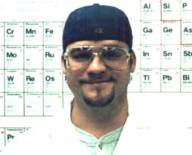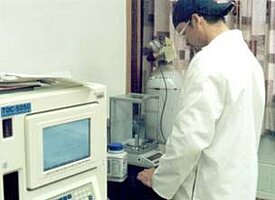Modeling the Hydrogeochemistry of Denitrification in In-Situ Microcosms in the Elk Valley Aquifer

Paul Skubinna is from Stillwater MN. He completed a B.S. in Geological Engineering at UND, with emphasis in hydrogeology, in May 1998, and is writing his M.S. thesis in Geology. He would like to work with a state agency or the EPA where he could be involved in compliance enforcement, site investigations and remediation. His long-range goal is to establish an environmental engineering and consulting firm.
Fellow: Paul A. Skubinna, Department of Geology and Geological Engineering, UND
Advisor: Scott F. Korom, Assistant Professor of Geology and Geological Engineering, UND
Matching Support: North Dakota Department of Health, Bismarck; North Dakota State Water Commission, Bismarck
Degree Progress: M.S. completion anticipated in August 2001.
Modeling the Hydrogeochemistry of Denitrification in In-Situ Microcosms in the Elk Valley Aquifer
Nitrate is one of the most common groundwater contaminants observed in aquifers. In areas where agricultural activity is prominent, nitrate from fertilization may infiltrate and contaminate aquifers like the Elk Valley Aquifer (EVA) in Eastern North Dakota. The objective of this study is to gain a better understanding of the geochemical processes associated with the denitrification observed in the EVA. The research is focused on reaction paths, rates, products, denitrification capacities, and prediction of potential undesirable secondary products associated with the denitrification.
The methodology of this study has been to replicate the experiment done by Schlag and Korom using in-situ mesocosms (ISMs) located near Larimore, ND. The approach incorporates fieldwork and analytical lab work, with the addendum of computer modeling. The fieldwork consisted of amending groundwater contained within the ISMs with potassium nitrate and potassium bromide on October 8, 1998, followed by monthly sampling of the amended water using the protocol outlined by Standard Methods. Sample analyses for general anions, cations and other basic water parameters were performed by North Dakota Department of Health. Bromide analysis, along with duplicate analysis of dissolved carbon, nitrate-nitrogen, and sulfate, were performed at the UND Water Quality Lab.
Since October 8, 1998 the ISMs have been sampled fifteen times on an approximate monthly schedule. Sample analysis indicated a decrease of 5-10 mg/L NO3-– N per month. As of February 19, 2000 nitrate-nitrogen concentration in the R-ISM had been totally degraded to an effective concentration of 0 mg/L. The initial nitrate value was approximately 105mg/L. Bromide concentration in the R-ISM remained approximately 45 mg/L at that time. In the ISM amended with KBr only (referred to as the C-ISM), the Br- concentration, which began the study at approximately 720mg/L, was approximately 600mg/L. Bromide observations in both ISMs indicate its effectiveness as a relatively conservative tracer.
Sulfate concentrations in the R-ISM increased to approximately seven times the initial concentration at the end of denitrification while the sulfate concentration in the C-ISM remained roughly constant. Comparatively, dissolved inorganic carbon (DIC) concentrations displayed little fluctuation in either the C-ISM or the R-ISM. This suggests that denitrification by sulfide minerals is the prominent process in this groundwater system. However, dilution accounted for, sulfate production in the R-ISM does not stoichiometrically account for all missing nitrate. Though sulfide minerals may be thermodynamically favorable electron donor, it appears organic carbon (OC) is also participating in the denitrification process. Possibly, denitrification sourced DIC is being offset by a secondary DIC sink reaction resulting in no net observable increase.
Comparing the data set of the second tracer test to that of the first tracer test performed by Schlag, the following conclusions are apparent: (1) Denitrification rates in the second tracer test are about half of those observed in the first tracer test.(2) Percent of denitrification by sulfide minerals, accounted for by sulfate production, decreased in the second tracer test to 48 – 73% vs. 61-89% in the first tracer test.(3) Nitrogen isotope fractionation analyses suggests a more electron donor deficient environment in the second tracer test than first tracer test.
Extensive hydrogeochemical modeling with PHREEQC-2 has been done to improve the understanding of the synthesis of processes and secondary reactions associated with the denitrification. Current efforts have the following objectives: to model the observed state of geochemical thermodynamic disequilibrium within the ISMs during the tracer test; to gain more substantiated evidence of OC’s role as an electron donor to the observed denitrification; and to gain insights and propose a possible scenario of major geochemical reactions associated with study methodology, naturally occurring processes and observed redox.
The latest modeling methodology has substantiated pyrite as a major electron donor to denitrification, suggested the formation of iron oxy-hydroxides as a product of denitrification by pyrite, and provided a more substantiated line of evidence that OC is simultaneously active as a second major electron donor to denitrification.
Presentations
Korom, S. F., A. E. Kammer, A. J. Schlag, and P. A. Skubinna, In-situ study of denitrification in the Elk Valley Aquifer, North Dakota, EOS, Transactions, American Geophysical Union/Supplement, 82(20), S168, 2001 (Abstract)
Skubinna, P. A., and S. F. Korom, In-situ study of denitrification in the Elk Valley Aquifer: Second tracer test, EOS, Transactions, American Geophysical Union/Supplement, 82(20), S168, 2001 (Abstract).


Scott F. Korom
Geology & Geological Engineering
UND


